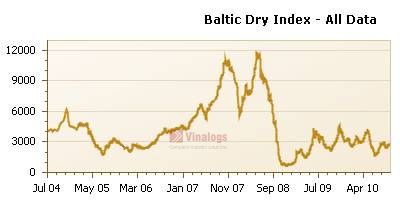Baltic Dry Index (BDI)
Baltic dry index, or BDI for short, is a number issued daily by the London-based Baltic Exchange to measure the rates charged for chartering the giant ships that carry major raw materials, i.e. coal, iron ore, crude oil, and grain.
Despite of its name’s suggestion, the index is not restricted to Baltic Sea countries. It tracks worldwide international shipping prices of various dry bulk cargoes.
This index is updated five days a week and is readily available for your reference. How to find it? From direct Baltic Exchange's website, or from some other online resources like Bloomberg
History
BDI traces its history back to 4 January 1985, when The Baltic Exchange commenced publication of a daily freight index - the Baltic Freight Index (BFI), the predecessor of BDI.

The BFI, which initially consisted of 13 voyage routes covering cargoes from 14,000 mt of fertiliser up to 120,000 mt of coal, and no timecharter routes, was developed as a settlement mechanism for the newly-established Baltic International Freight Futures Exchange (BIFFEX) futures contract. It quickly won worldwide acceptance as the most reliable general measure of the dry cargo freight market.
On 1 November 1999 - the BPI replaced the BFI as the instrument of settlement for BIFFEX.
Since then, there’ve been many changes to the component and calculation method of the Baltic Dry Index
. Changes occurred in route selection, size and type of selected vessels, add time charter rates, etc. Listing details of all those changes is a long story. If you’re interested, just down load full history of BDI here.
Usage
The index provides investors and others with an idea of how much it will cost to move major raw materials by sea (in bulk, hence the name).
Changes in the Baltic Dry Index can give investors insight into global supply and demand trends. This change is often considered a leading indicator of future economic growth (if the index is rising) or contraction (index is falling) because the goods shipped are raw, pre-production material, which is typically an area with very low levels of speculation.
Because the supply of large carriers tends to remain very tight, with long lead times and high production costs, the index can experience high levels of volatility if global demand increases or drops off suddenly.
The Baltic Exchange also operates as a maker of markets in freight derivatives, a type of forward contract known as FFAs (forward freight agreements) that are traded over-the-counter.
BDI Composition
Along the index’s history, the number of component routes changes according to the assessment a judging panel. As of October 2010, BDI is calculated on 20 individual shipping routes detailed in the table below.
| Route | Description | Weightings |
| 4 Capesizes T/C routes (with 6 other voyage charter routes) to form BCI | ||
| C8 | 172000mt Gibraltar/Hamburg trans Atlantic RV | 25% |
| C9 | 172000mt Continent/Mediterranean trip Far East | 25% |
| C10 | 172000mt Pacific RV | 25% |
| C11 | 172000mt China/Japan trip Mediterranean/Cont | 25% |
| 4 Panamax T/C routes to form BPI | ||
| P1A | 74000mt Transatlantic RV | 25% |
| P2A | 74000mt SKAW-GIB/FAR EAST | 25% |
| P3A | 74000mt Japan-SK/Pacific/RV | 25% |
| P4 | 74000mt FAR EAST/NOPAC/SK-PASS | 25% |
| 6 Supramax T/C routes to form BSI | ||
| S1A | 54000 mt Antwerp - Skaw Trip Far East | 12.5% |
| S1B | 54000 mt Canakkale Trip Far East | 12.5% |
| S2 | 54000 mt Japan - SK / NOPAC or Australia rv | 25% |
| S3 | 54000 mt Japan - SK Trip Gib - Skaw range | 25% |
| S4 | 54000 mt US Gulf - Skaw-Passero | 12.5% |
| S4B | 54000 mt Skaw-Passero - US Gulf | 12.5% |
| 6 Handisize T/C routes to form BHSI | ||
| HS1 | 28000mt Skaw / Passero - Recalada / Rio de Janeiro | 12.5% |
| HS2 | 28000mt Skaw / Passero - Boston / Galveston range | 12.5% |
| HS3 | 28000mt Recalada / Rio de Janeiro-Skaw / Passero | 12.5% |
| HS4 | 28000mt US Gulf / NC South America - Skaw / Passero | 12.5% |
| HS5 | 28000mt SE Asia via Australia - Singapore / Japan | 25% |
| HS6 | 28000mt S Korea/Japan - S'pore/Japan range incl. China | 25% |
Please note that the component routes may be changed over time. If you want to stay updated, just follow up the history of BDI, which is updated regularly.
Besides, Baltic Dry Index includes 4 separate sector indices that measure different sizes of dry bulk vessels:
- BCI: Baltic Capesize Index
- BPI: Baltic Panamax Index
- BSI: Baltic Supramax Index
- BHSI: Baltic Supramax Index
BDI Calculation
Calculation formular
BDI = ((CapesizeTCavg + PanamaxTCavg + SupramaxTCavg + HandysizeTCavg)/ 4) * 0.113473601
Where TCavg = Time charter average; and The multiplier (0.113473601) was first applied when the BDI replaced BFI, and has changed over the years as the contributing indices and the methods of calculation have been modified.
Calculation steps
- Determine actual values of T/C rates on 20 routes (well, this is another complicated tasks, perhaps they are calculated by average rates of the vessels of selected type and size on selected routes
- Multiply T/C rates of each route by corresponding weightings to achive the TC average of each type (Capesize, Panamax, …)
- Calculate BDI as per above formular.
Calculation illustration
I collected data and tried calculating the indexes so that I can understand more clearly the structure and components of the indexes. You can down load the calculation in xls. file here (you need to unzip it first).
Chart of the Baltic Dry Index
Look at the chart below and see how the index has fluctuated over years. If you want to see a complete chart of the BDI since its replacement to BFI in Nov 1999, click here.
It got a peak several times, remarkably in the duration from 2003-2004 and 2007-2008. Also, it plummeted in the end of 2008, signifying a crisis in dry cargo market.

Return to Home Page from Shipping Indices
Return to Home Page from Baltic Dry Index
New! Comments
Have your say about what you just read! Leave me a comment in the box below.